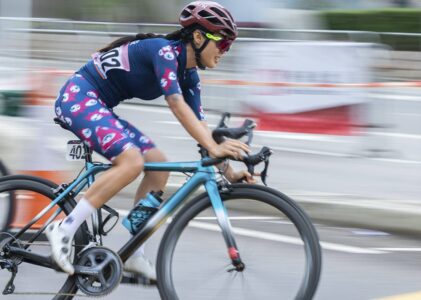Track races are bicycle races on a cycle track with a wooden surface and a circumference of 250 m. On the straight part, the angle of inclination is 12.4°, on the curve – 42°. Held on special tracks of oval shape with a length of 133 to 500 meters (World Championships and the Olympic Games – from 250 to 400 m. The width of the track must be uniform throughout its length and be at least 5 m (for tracks of the highest category – at least 7 m). Markings on the track (sprint and steer lines, finish line, etc.) shall be of contrasting colors. Results (in time races) are recorded to the nearest thousandth of a second.
Track Bikes
Track bikes are similar to road bikes, but they are noticeably lighter than road bikes. Road racing bikes can vary in weight depending on the construction materials used, but they usually weigh about 9 kg. Mass same track racing bikes, devoid of brakes, derailleurs and other minor units and parts, can be as little as 7 kg In order to reduce weight on them is not put a number of equipment – the brakes, derailleurs. It is impossible to stop spinning while riding, so braking a track bike is a few laps around the track with a gradual deceleration. There is no other way. Track bikes in addition to low weight have excellent aerodynamics and downforce. Therefore, a track bike has a minimum number of components. To increase inertia and improve aerodynamics often do not use spokes – the wheel is tightly closed with carbon. Straps are used on the pedals and the foot is strapped to the pedal while riding, in such a way that it becomes impossible to release by a simple movement of the foot. This is done so that the cyclist does not lose speed on the track or get injured.
The main types of track racing
There are many types of races: time race (Git from the spot), sprint, individual pursuit, team pursuit, points race, madison, keirin, Olympic sprint, scratch, tandem, leaderboard race, elimination race, 6-day races.
Race against time (Git from the spot) (1 km for men and 500 m for women) – the race of one racer for time. His task is to reach maximum speed as fast as possible and try to keep it to the finish line. Git does not require any tactics – only strength and technique. Winners of races are often separated by fractions of a thousandth of a second.
Sprint (200 m). The total length of the distance – 1 km, but in the set-off go only the final 200 meters. Having started simultaneously, the two racers strive to occupy the most advantageous position for the finish sprint. The second position is more preferable as it enables an opponent to unexpectedly “add” and surge ahead. During tactical maneuvers the athletes use the whole width of the track. Often they stop and, balancing on the spot, conduct a tactical struggle. The sprint competition starts with a qualification round and is followed by a knock-out system. The best qualification time is paired with the slowest competitor, the second fastest with the penultimate competitor, etc. The winner of two heats passes to the next stage of competitions (in case of a draw to determine the winner there is a third additional heat).
Individual pursuit race (4 km – men, 3 km – women). Two racers start simultaneously on opposite sides of the track. The race is won by the one who manages to catch up with an opponent or the first to finish (if the racers have the same time, the athlete who was fastest in the final lap wins). As in the sprint, the competition in this type of program begins with qualifying heats, followed by a knock-out. The pursuit race requires endurance, fine-tuned technique, concentration, mental toughness and tactical calculation. Some athletes aim to gain an immediate advantage through a strong start and then retain it throughout the race, while others, on the contrary, rely on the finishing spurt.
The team pursuit (4 km) is only for the men’s teams (4 competitors each). Total time is recorded at the moment when the front wheel of the third team cyclist crosses the finish line (the team can also achieve early victory – if it manages to overtake an opponent: the third of its riders must catch up with the third rider of the other team). Partners go in a tight group – literally a few centimeters behind each other. Proper tactics and distribution of duties determines a lot. Often one of the riders “drives” the team, and shortly before the finish skips ahead partners who have saved more strength for the finishing spurt.

